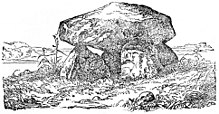Great stone graves in Denmark

The Neolithic bearers of the funnel beaker culture (TBK) began building large stone graves in Denmark around 3500 BC. In the following 700 years, until the end of the TBK around 2800 BC. According to estimates by Danish sources, around 20,000 dolmens and over 6,000 passage graves were built here. 4700 dolmens , Danish dysser , and over 700 passage graves , Danish jættestuen , are documented. 2800 have been preserved and around 2400 of them are protected.
The oldest Dolmen are small, rectangular, closed on all sides Simple dolmen . Small stone boxes on North Zealand and Konens Høj systems , especially in Jutland, are regarded as their forerunners . The early stone boxes were also made from boulders or had a megalithic capstone. Undisturbed finds show that most of the dead were not deposited in the skeletal structure, but there are also complete skeletons. An excavation near Bøjden on Funen showed that even the oldest dolmen shapes could (rarely) be polygonal . The chambers were built in round or long hills, which were surrounded by a curb chain.
Somewhat younger is a dolmen type in which one side chamber stone is lower than the others, so that it forms a threshold stone , a boundary mark at the entrance to the chamber. Sometimes one or two pairs of stones are placed in front of the corridor; later the aisle lengths are up to ten meters.
From around 3300 BC The polygonal pillars with polygonal chambers are created in the 4th century BC . At the same time, large dolmen , in Danish stordysser , and passage graves also appear. While the passage graves in Jutland are oval, the island Danish, probably somewhat younger, have sometimes very large, always rectangular chambers. The skeletons of around a hundred dead lay in some of the passage graves excavated on Zealand . Complete skeletons were found lying on their back or side. In addition, skeletal parts had also been brought in, some of them sorted according to bone type.
Most of the passage graves are located in round hills; but on Langeland (e.g. passage grave from Myrebjerg ) and Lolland ( Kong Svends Høj ) there are often giant beds . Gaps between the boulders were filled with an intermediate brickwork of stacked flat stone slabs. The floor of the chamber was paved with layers of different materials. The facilities were closed with stone slabs, which made it possible to use the collective graves intermittently. If the use was finally stopped, the access was blocked with stones.
Around sixty passage graves built as double systems, Danish dobbelt- or tvillingejættestue , are known. Here two chambers are located close to each other in the same hill (e.g. Ettrup ) or have common bearing stones on their neighboring narrow sides (e.g. Klekkende Høj ).
Thirty of the Danish passage graves have side chambers, in Danish jættestue med bikammer . 25 of these systems can be found in Jutland around the Limfjord (e.g. Lundehøj ), three on Zealand (e.g. Hørhøj ), two each on Lolland ( Bag-Hyldehøj ) and Falster .
The Hvisselhøj is unique , in which a central corridor opens up three parallel chambers, which are arranged one behind the other like three shorter loaves of bread. The secondary chambers were built at the same time as the main chamber. That they had a special function is deduced from the fact that quarters were built elsewhere around this time , which show an even more differentiated division of the chambers.
The Danish megalithic radiated to Schleswig-Holstein and Sweden or was influenced by there.
See also
literature
- Ingrid Falktoft Andersen: Vejviser til Danmarks oldtid . 1994, ISBN 87-89531-10-8 , pp. 19-21 .
- Klaus Ebbesen : The younger funnel cup culture on the Danish islands. Akademisk Forlag, Copenhagen 1975, ISBN 87-500-1559-1 .
- Klaus Ebbesen: Tragtbægerkultur i Nordjylland. Study over jættestuetiden. Det Kongelige Nordiske Oldskriftselskab, Copenhagen 1979, ISBN 87-87438-16-5 .
- Klaus Ebbesen: Stordyssen i Vedsted. Study of bearer cultures in Southern Jutland. Akademisk Forlag, Copenhagen 1979, ISBN 87-500-1889-2 .
- Klaus Ebbesen: Bornholms dysser og jættestuer. In: Bornholms Historiske Samfund. Volume 18, 1985, pp. 175-211 ( online ).
- Klaus Ebbesen: Stendysser og jaettestuer. Odense universitetsforlag, Odense 1993, ISBN 87-7492-918-6 .
- Klaus Ebbesen: Danske dysser - Danish dolmens. Attika, Copenhagen 2007, ISBN 978-87-7528-652-2 .
- Klaus Ebbesen: Danmarks megalitgrave. Volume 2. Catalog Attika, Copenhagen 2008, ISBN 978-87-7528-731-4 ( online ).
- Klaus Ebbesen: Danske jættestuer. Attika, Vordingborg 2009, ISBN 978-87-7528-737-6 .
- Klaus Ebbesen: Danmarks megalitgrave. Volume 1/1. Attika, Vordingborg 2011, ISBN 978-87-7528-784-0 .
- Klaus Ebbesen: Danmarks megalitgrave. Volume 1/2. Attika, Copenhagen 2011, ISBN 978-87-7528-785-7 .
- Barbara Fritsch et al .: Density Centers and Local Groups - A Map of the Great Stone Graves of Central and Northern Europe. In: www.jungsteinsite.de. October 20, 2010 ( PDF; 1.6 MB , XLS; 1.4 MB ).
- Peter Vilhelm Glob : prehistoric monuments of Denmark. Wachholtz, Neumünster 1968.
- Svend Hansen : Jaettestuer i Danmark. Construction and restoration. Miljøministeriet, Skov- og Naturstyrelsen, Hørsholm 1993, ISBN 87-601-3386-4 .
- Jørgen Jensen : Danmarks Oldtid. 1. Stenalder. 13,000–2,000 f.Kr. Gyldendal, Copenhagen 2001, ISBN 87-00-49038-5 .
- Jürgen E. Walkowitz: The megalithic syndrome. European cult sites of the Stone Age (= contributions to the prehistory and early history of Central Europe. Vol. 36). Beier & Beran, Langenweißbach 2003, ISBN 3-930036-70-3 .


